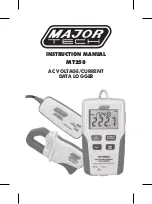
HOBO U20 Water Level Logger Manual
1-800-LOGGERS 5
www.onsetcomp.com
Stilling Well
If you are deploying the logger in a lake, river, or stream, you
must first build a stilling well to protect the logger from
vibration, shock, and movement.
A simple stilling well can be constructed with PVC or ABS pipe.
A properly constructed stilling well helps to protect the logger
from currents, wave action, and debris. Suspend the logger in
the stilling well so it is always underwater, but not on the
bottom to be buried by silt.
For more information, see the Technical Application Note for
Constructing a Stilling Well at:
http://www.onsetcomp.com/water_level_stilling_well.html
Burst Pressure
Be very careful not to exceed the burst pressure for the logger.
The pressure sensor will burst if the maximum depth is
exceeded (see specifications table). The logger should be
positioned at a depth where the logger will remain in the water
for the
duration of the deployment, but not exceed the rated
bursting depth.
Deployment Procedure
1.
Cut wire to suspend logger.
a.
Measure the physical depth to the surface of the water
from the suspension point.
b.
Cut a piece of stranded, stainless steel wire (Teflon
coated is best) so that the logger will be deep enough to
always be in the water. Estimate the low water level and
make the cable length such that the logger will be about
2 feet below that level.
2.
Attach the wire to the suspension point and to the logger
cap.
3.
Relaunch the logger if desired (if a PC or a HOBO U-Shuttle
is available).
4.
Lower the logger into the well or stilling well.
5.
Measure the water depth from the desired reference point
(top of pipe, ground level, or sea level).
•
To maximize accuracy, allow 20 minutes after deploying
the logger before measuring water depth to allow the
logger to reach temperature equilibrium with the water.
•
If the well is too small in diameter to measure the water
depth after deployment, measure the water depth
before deployment, then deploy the logger immediately
and record deployment time.
•
For well deployments: If the water level surface is below
the reference point (such as referencing groundwater
measurements to the top of the well), record the water
level as a negative number. If the water level surface is
above the reference point (such as height above sea
level), record the water level as a positive number.
•
For lake, stream, and river deployments: If the water
level is being referenced to some point above the logger
(such as the top of the stilling well), record the water
level as a negative number. If the water depth is being
referenced to a point below the water surface such as
the bottom of the stream, record the water level as a
positive number.
6.
Record the reference measurement date and time.
Deploying a U20 Logger for Barometric
Pressure Data (Optional)
If you are using a U20 logger to record barometric pressure
data, install one logger in one of the wells as follows:
1.
Cut wire for suspending the logger.
a.
Measure the physical depth to the surface of the water
from the suspension point.
b.
Cut a piece of stranded, stainless steel wire (Teflon
coated is best) so that the logger will hang about 2 feet
below the ground surface but always above the water
surface.
2.
Attach the wire to the suspension point and to the logger
cap.
3.
Relaunch the logger if desired (if a PC or a HOBO U-Shuttle
is available)
4.
Lower the logger into the well or stilling well. Make sure the
logger does not go below the water surface.
5.
Record the deployment time.
Collecting Data
For reading out the Water Level logger in the field, you can use
either of the following:
•
Laptop computer with HOBOware Pro and an Optic USB
Base Station (BASE-U-4), with a coupler (COUPLER2-B)
•
HOBO Waterproof Shuttle (U-DTW-1) with a coupler
(COUPLER2-B)
1.
Measure the water depth using the original reference point
with the correct sign.
2.
Record depth and date and time.
3.
Pull the logger out of the well.
4.
Remove the logger from its cap, leaving the suspension
undisturbed.
5.
Readout the data using one of the options listed above.
6.
Save the data in a test folder location.
7.
Redeploy the logger (optional). See below.
Barometric Pressure Data
To read out a U20 logger used for barometric pressure data:
1.
Remove the logger from the well.
2.
Readout the data using one of the options listed above.
3.
Save the data in a test folder location.
4.
Redeploy the logger (optional). See the next section.





















